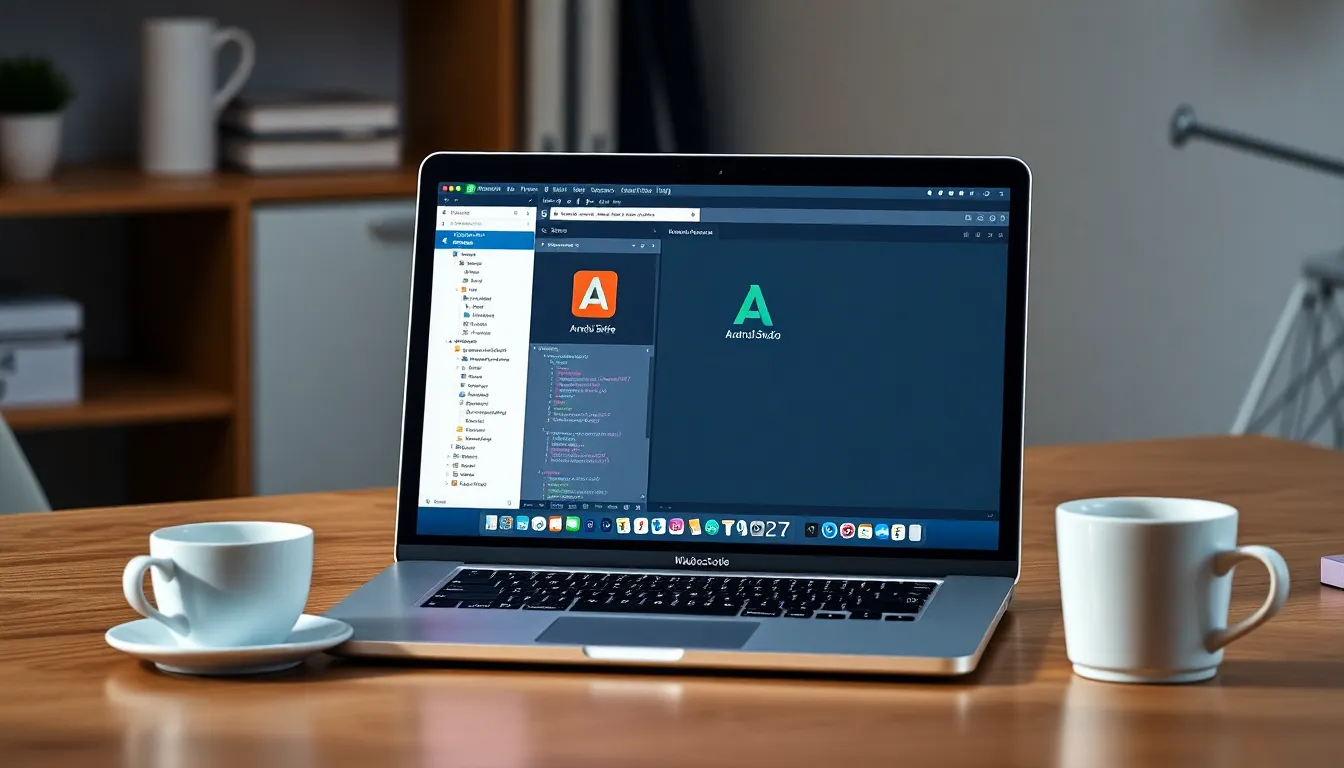For aspiring app developers, downloading Android Studio on a Mac is like finding the holy grail of coding. It’s the gateway to transforming brilliant ideas into stunning applications, all while sipping a latte at your favorite café. But let’s face it—navigating the download process can feel like trying to solve a Rubik’s Cube blindfolded.
Android Studio Download Mac
Android Studio serves as the official Integrated Development Environment (IDE) for Android app development. Its robust features empower developers to build high-quality applications for mobile devices.
What Is Android Studio?
Android Studio is a powerful IDE built specifically for Android development. It includes everything necessary for coding, debugging, and testing Android applications. The environment simplifies tasks such as project management and code editing. Users access tools for performance tuning and deployment, facilitating a smoother development process. Google’s commitment to Android Studio guarantees regular updates, ensuring developers benefit from the latest tools and features.
Key Features of Android Studio
Android Studio boasts numerous features that cater to developers’ needs. A user-friendly interface enhances productivity, making it easier to navigate various functions. Integrated tools like the Android Emulator allow for real-time testing on virtual devices. The layout editor provides drag-and-drop functionality for designing app interfaces intuitively. Code completion features accelerate the writing process by suggesting relevant syntax and methods. Version control integration supports collaborative work, enhancing team productivity. These features create an efficient environment for Android app development.
Steps to Download Android Studio on Mac

Downloading Android Studio for macOS involves several straightforward steps. Understanding the requirements and the process simplifies the task significantly.
System Requirements
macOS 10.14 or later is necessary for installing Android Studio. At least 4 GB of RAM is recommended, though 8 GB enhances performance. Storage should provide a minimum of 2 GB of available space, along with additional space for Android SDK. A modern processor enhances efficiency during development. Ensure that the Apple JDK version 8 or newer is installed. Check compatibility with existing software and hardware for optimal performance.
Downloading the Installer
Begin the download by visiting the official Android Studio website. Locate the download button specifically for macOS and click it. The download begins automatically, fetching a DMG file. Monitor the progress in the browser’s download manager. Once the download completes, locate the DMG file in the Downloads folder. This file contains the installer necessary for the installation process.
Installation Process
Open the DMG file to initiate the installation. Drag and drop the Android Studio icon into the Applications folder to begin the installation. Launch Android Studio from the Applications folder after moving it. Follow the setup wizard prompts to configure the installation. Select the standard installation for most users, which includes Android SDK and other essential tools. Complete the setup by following the on-screen instructions and accepting license agreements. This process finalizes the installation, making Android Studio ready for use.
Setting Up Android Studio on Mac
Setting up Android Studio on a Mac creates a seamless environment for app development. This process involves specific configurations for optimal performance.
Initial Configuration
First, launch Android Studio after installation. The setup wizard appears and prompts users to configure essential settings. Selecting the standard installation option typically suffices for most developers. Users can also opt for a custom installation, allowing for tailored components. Additionally, it’s crucial to ensure that the Android SDK is downloaded during this configuration step. This software development kit contains the necessary tools for building Android apps. Verify installation by accessing the SDK Manager in the IDE for future updates. Completing this step establishes a solid foundation for subsequent development tasks.
Creating Your First Project
To create a first project, users should navigate to the “File” menu and select “New Project.” The setup wizard facilitates choosing from various project templates. Each template provides a specific layout and functionality tailored for different app purposes. After selecting a template, users assign a name and a package name, which serves as the app’s unique identifier. Specify the save location to keep organized. During this step, it’s essential to select the minimum API level compatible with targeted devices. Once finished, click “Finish” to initialize the project. Android Studio automatically generates the necessary files, setting the stage for coding and development.
Tips for Using Android Studio on Mac
Enhancing the experience with Android Studio on Mac can lead to better app development outcomes. Developers should focus on performance optimization and troubleshooting common issues.
Optimizing Performance
Improve Android Studio’s performance by allocating sufficient memory. Adjust the IDE’s settings to increase the heap size, ensuring smooth operation. Disabling unnecessary plugins and turning off unused features like instant run further enhances responsiveness. Deleting unused projects from the welcome screen clears clutter. Keeping the IDE updated allows access to performance improvements. Lastly, optimizing the Gradle build by applying the latest version can reduce build times and enhance the overall development experience.
Troubleshooting Common Issues
Developers might encounter frequent lag during coding. Restarting Android Studio often resolves temporary performance issues. Occasionally, the emulator might fail to start. Checking AVD settings and ensuring proper system images are installed can help. If facing issues with Gradle sync, reviewing the build.gradle file for errors often reveals the cause. Misconfiguration of SDK paths can lead to errors; verifying these in SDK Manager addresses the problem. Regular maintenance of the IDE, including cache clearing, prevents many common issues from recurring.
Conclusion
Downloading Android Studio on a Mac opens the door to endless possibilities for app developers. With its powerful features and user-friendly interface, it transforms ideas into functional applications. The installation process might seem daunting at first, but following the outlined steps makes it manageable.
Once set up, developers can dive into creating their first projects while optimizing performance through various tips. Regular updates ensure access to the latest tools, enhancing the overall development experience. By embracing Android Studio, developers are well on their way to crafting innovative mobile applications that can make a significant impact in the tech landscape.



